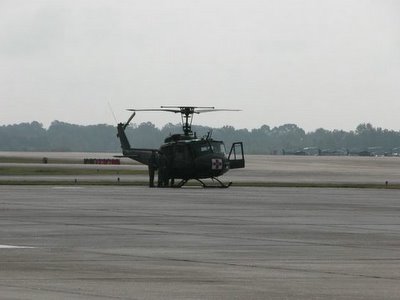Pixy stix gone wrong
photo by Paul Treuting

The waterline halfway up the siding on this house in Picayune, Mississippi, means that although it's still standing, it will need to be rebuilt. The orange markings indicate that the house was searched by rescue teams, and no bodies were found.
Brother Paul Treuting, president of Local 1707 of the Laborers International Union (North America), kindly sent AFGE his account of New Orleans, his hometown, after the storm, a story he originally sent his LIUNA collegues in late September. Treuting works on a National Guard base in Mississippi.
FORT WORTH, TEX.--We evacuated our F-15's here on August 27th, before Katrina hit our area. We (14 of us) came here on September 19th to check on the status of our aircraft and were told to stay in place until Hurricane Rita passed thru the Gulf.
We have been in another world since Katrina wasted the Louisiana, Mississippi and Alabama coasts. We were activated by our state government to assist with the disaster around us. I wasn't able to get home until September 16. I left my family secured at home the day Katrina ran her swath thru our community. I could write a book on the things that hapened those few days; worried to death of my family's security while the eye passed over my home as I watched it on the news; taking bottled water showers; escorting a convoy thru the flooded streets of the city I grew up in. I finally got a few days off to go home.
When I drove down the country road to my house, it looked like a bomb went off. Hundreds of pine trees were snapped in half, as if bowing to the torment of Katrina's merciless wind. Others were uprooted in place, as if Katrina's big shoes shoved them over. Our front yard, which had beautiful draping oaks, is now open to the blue skies, the limbs and branches scattered everywhere. Power poles still standing seemed to struggle to hold up the dangling wires, which looked lke Silly String.
Other poles and transformers had been crushed by the toppled trees. I was planning on gathering firewood for our fireplace; now it's in abundance.
Thankfully my home was still intact and my family survived without a scratch. Thank the Lord for answered prayers!
I live in Picayune, Miss., which is 60 miles from New Orleans. I was able to drive from home into the city. Since I have a military ID, I was allowed to pass throughout the city. Coming in from the east (one of the hardest-hit areas), the six-lane I-10 was empty and flooded in some areas. Once reaching the habited area, I was awestruck by all the homes and cars that were flodded. You could see the waterline stains from the receeding water on the vehicles and houses. Where were all the people who once went about their daily lives here?
The flood left a smell I won't soon forget. Everywhere I stopped to take pictures, I could smell the stench of destruction. It conveyed everything the floodwaters came in contact with, mixed together and dried up on everything. The trees and grass started to turn brown and rust color from all the pollution that a standing flood brings--a slow death.
Tulane Avenue, one of the main streets, runs from downtown out west. I took a photo of it because since the road was built, it never looked like this. Flooded cars and businesses lined the avenue. All the traffic lights looked "empty;" I felt as if I was looking into the eyes of a dead person. No electricity to give them life. The sun set slowly set behind a redish haze. I was photographing from the part of I-10 that runs thru the city; I could count on one hand the vehicles that passed by. Most of them were police, emergency or military.
As I crossed the Mississippi River, the downtown looked like a black hole. The skyscrapers had no lights and the Superdome looked like Superman with his cape ripped off. The white roof covering hung over the side in shreds. I continued down Terry Parkway on the westbank, passing homes that still had the windows and doors boarded up. Fences were on their sides and tree limbs still littered the streets.
Those areas that were flooded were searched for the living by Task Force Teams from Colorado, New Mexico, Nevada, Missouri, New Hampshire and California. Listening to those folks' stories at dinner was amazing.
Where the water stopped is where they launched their boats. Each team was given a neighborhood to search. They would go door-to-door, knocking and beating on a home for any response. Some folks were still in their attics and replied with their frantic calls. Many were rescued through holes that were either axed or chain-sawed. Homes where bodies were found were marked with red spray paint and the location marked by GPS coordinates.
When possible, the bodies were secured with care and respect, so not to float around. In some areas, the water was three to four feet deep. In other parts, houses were submerged to the roof peaks.
Now we have to deal with the southwest part of our state from Rita's wrath. Lots of farmland is ruined. The sugarcane fields were shredded and smashed by the forceful winds and tidal surge. Cotton fields are soaked.
Many livestock wander without direction. The dead corpses lay bloated and baking in the scorching summer heat. Many small coastal towns and communities are obliterated like a game of Pixy Stix gone wrong.
I think the hardest part of our recovery will be getting businesses started up again. We rely so much on grocery, retail and services. These business have suffered the same as homeowners. It will be a long hard struggle to overcome. I really don't think New Orleans will be the same for a long time.
--Paul Treuting







